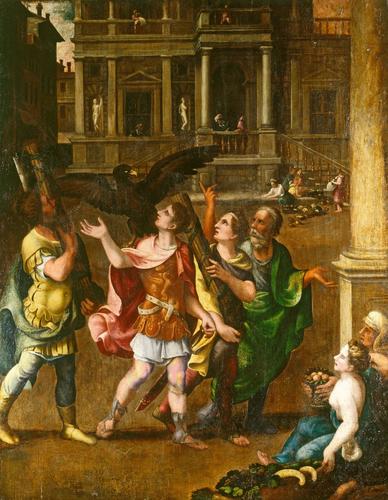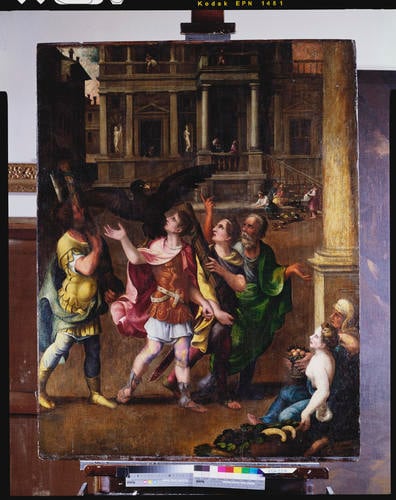The Omen of Claudius's Imperial Powers c.1536-9
Oil on panel | 121.4 x 93.5 cm (support, canvas/panel/stretcher external) | RCIN 402806
-
This is one of five panels in the Royal Collection by Giulio Romano that originally belonged an elaborate decorative scheme for the state apartments within the Palazzo Ducale, Mantua. This panel comes from one of the grandest rooms, the Camerino dei Cesari (Cabinet of the Caesars), the decoration of which consisted principally of eleven powerful canvases of the Roman Emperors by Titian. The subject matter is drawn from Suetonius’s Lives of the Caesars, and reflects Federico Gonzaga’s obsession with imperial themes. Completed in 1540, Titian’s images were sadly destroyed by fire in Spain in 1734.
Giuilo played a subsidiary role in the decoration of the room; responsible for the broader ensemble into which Titian’s ‘portraits’ were fitted, he provided scenes from the life of each Emperor, to be placed below the portraits (of the original eleven only four have survived, three are in the Royal Collection). Flanking these scenes were mounted figures by Giulio representing the Emperors, and one female figure with a horse representing Victory (there were probably originally twelve of these figures, of which nine survive, two are in the Royal Collection). The ensemble of three walls (omitting the west wall) is recorded by drawings attributed to Ippolito Andreasi, c.1568 (Museum Kunst Palast, Düsseldorf), commissioned by the antiquarian Jacopo Strada. The relationship between the grand Titian figures and Giulio’s narrative scenes below has been compared to the hierarchy of an altarpiece: the predella with anecdotal scenes from the life of the saint who is depicted above, standing in majesty. Giulio’s skill lay in the illusionistic ensemble, bringing together architecture, painting and sculpture, designed to complement Titian’s work.
The Omen of Claudius’s Imperial Powers was painted to hang beneath Titian’s Claudius on the east wall of the Cabinet of Caesars. The subject is taken from Suetonius’s Twelve Caesars (V, 7): Claudius, created a consul by his nephew the Emperor Gaius, received an omen of his future greatness, ‘as an eagle that was flying by lit upon his shoulder’. The eagle was the symbol of Imperial Rome, and also appeared on the coat of arms of the Gonzaga family, which is presumably why this incident was chosen and why the eagle here has its wings outstretched in such a heraldic fashion. Claudius’s profile no doubt derives from an antique medal. Claudius and his military escorts, all dressed all’antica, contrast with the spectators in the background who are dressed in contemporary costume. The palace, with its giant Doric pilasters and columns, rustication and statues in niches, is reminiscent of the Palazzo Te, particularly its east façade, towards the fishponds.
Provenance
Gabinetto dei Cesari, Palazzo Ducale, Mantua; 1627 Mantuan inventory; acquired by Charles I; recorded in the Long Gallery at Whitehall in 1639 (no 7); listed as reserved in the Commonwealth Sale and valued at £34 (Pictures in the Committee Rooms); recovered at the Restoration and listed in the 2nd Privy Lodging Room at Whitehall in 1666 (no 171)
-
Creator(s)
Acquirer(s)
-
Medium and techniques
Oil on panel
Measurements
121.4 x 93.5 cm (support, canvas/panel/stretcher external)
133.0 x 105.4 cm (frame, external)
Category
Object type(s)
Other number(s)
Alternative title(s)
Julius Caesar returning from the Senate House, previously identified as











